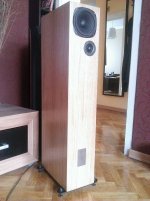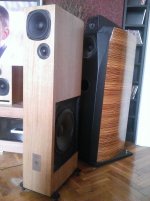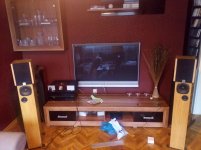I will look for the plans and design today, can send you also a 3D cad file for CNC routing (although my previous note about this woofer still holds, added costs of CNC for small quantity orders are usually expensive enough to make buying a better midwoofer like the NRX or Seas reed cone a better option). If you like it loud, this is not your woofer or you`d have to use 2 per side (so my crossover won`t work).
No need for CNC-router.
How to router this driver?
I would take some other driver for loud listening and serious hifi-speaker.
How to router this driver?
I would take some other driver for loud listening and serious hifi-speaker.
Wood: I have attached a zip file with all the pieces that are CNC-d - 3D .DXF files for the front panel so can directly give them to the routing company. They`re all 18mm except the front panel which is 25mm (900x170x25). I have also attached a file with the pieces needed, you can ask a company that sells plywood or mdf sheets to cut them for you, here its like EUR9 per sheet so decent. The woofer was sunk on these so a grille can be mounted, if you want to take the chance, you can mount it on a straight side instead, but that will pull it outwards and will affect the woofer-midwoofer crossover.
The crossover was comprised of these parts, it was functionally a Linkwitz-Riley both Woofer-Midwoofer and Midwoofer-Tweeter measured on midwoofer axis (with Jantzen numbers):
FL01 Crossover
Bass section
000-5499 - 25mH iron discs (these are expensive)
001-0077 - 120uF bipolar
Midwoofer
000-1078 - 1.1mH 0R57
000-1074 - 0.21mH 0R6 (the three values under the 1.1mH coil are a parallel LCR)
001-0242 - 3.3uF Cross cap
002-0442 – 3R6 MOX
Tweeter
001-0258 - 6.8uF Cross cap
000-1000 – 0.27mH 1R17 ( ideal value 0.265mH 0R9 )
002-0445 - 3R9 MOX (I do not remember if it was before crossover or after but have PCBs left and can check)
Unfortunately, the assembly instructions, crossover schematic and measurements are all gone. The base DXF file also, unfortunately. I built all so can help you with assembly instructions. But the hard drive, although with a stuck arm, was accessible after the failure, I bought some USB to hard drive adapter but need some extra power supply and a SATA cable to power it up as an external - if it works and I will do it in a week or so, I will be able to pull all files with all my projects, including this one and will add measurements. I remember the speaker was ruller flat from 1Khz upwards and the midwoofer had a pretty clean CSD plot.
The crossover was comprised of these parts, it was functionally a Linkwitz-Riley both Woofer-Midwoofer and Midwoofer-Tweeter measured on midwoofer axis (with Jantzen numbers):
FL01 Crossover
Bass section
000-5499 - 25mH iron discs (these are expensive)
001-0077 - 120uF bipolar
Midwoofer
000-1078 - 1.1mH 0R57
000-1074 - 0.21mH 0R6 (the three values under the 1.1mH coil are a parallel LCR)
001-0242 - 3.3uF Cross cap
002-0442 – 3R6 MOX
Tweeter
001-0258 - 6.8uF Cross cap
000-1000 – 0.27mH 1R17 ( ideal value 0.265mH 0R9 )
002-0445 - 3R9 MOX (I do not remember if it was before crossover or after but have PCBs left and can check)
Unfortunately, the assembly instructions, crossover schematic and measurements are all gone. The base DXF file also, unfortunately. I built all so can help you with assembly instructions. But the hard drive, although with a stuck arm, was accessible after the failure, I bought some USB to hard drive adapter but need some extra power supply and a SATA cable to power it up as an external - if it works and I will do it in a week or so, I will be able to pull all files with all my projects, including this one and will add measurements. I remember the speaker was ruller flat from 1Khz upwards and the midwoofer had a pretty clean CSD plot.
Attachments
Last edited:
The crossover of this one won`t work on a coaxial and I have not tried any coaxials indeed (ever!) 🙂 But you can use the CNC file, I believe they use the same chassis.
If you want a loud co-axial you should look at the Volt-6/8/10 kit from diysoundgroup. I have no idea if you can get them though.
If you want a loud co-axial you should look at the Volt-6/8/10 kit from diysoundgroup. I have no idea if you can get them though.
Ok, this can be one ideea but, from what I read about these kits, the tweeter are behind the woofer magnet and, at least for me, these kits seems to be intended to be use more for PA souround and less for HiFi speakers.
I would prefer the tweeter to be on the plane with the origin of the mid cone, if possible.
I would tend to get oriented to a 4-way speaker with SB13PFCC25-4 COAX, SB Acoustics SB16PFC25-8 6" and a some 10" side subwoofer, maybe something designed for auto use to work fine in small volum.
I want to obtain something not very expensive.
I think that this configuration can go louder.
Ok, this can be one ideea but, from what I read about these kits, the tweeter are behind the woofer magnet and, at least for me, these kits seems to be intended to be use more for PA souround and less for HiFi speakers.
I would prefer the tweeter to be on the plane with the origin of the mid cone, if possible.
Tannoy used this for many years. If you expect the acoustic centers to be coincident just because the tweeter and inner part of the midwoofer cone are alligned, there is a good chance they won`t - acoustic centers are not defined by the membrane radiating allignment. More to this, a small coaxial will require the cone to move a lot and this will introduce another set of problems as the waveguide-like loading the cone provides would move forward and backwards. A larger coaxial where the cone would move as little as possible would be better and will have higher power handling for your requirements.
The cone will to move a lot only if it is required by a low cross-over point.
My intention is to use a high cross-over point, 500-900hz, and the tweeter over 3-3.5Khz.
A larger coaxial need to be cut low, not over 2khz, to reject the resonance of the cone.
My intention is to use a high cross-over point, 500-900hz, and the tweeter over 3-3.5Khz.
A larger coaxial need to be cut low, not over 2khz, to reject the resonance of the cone.
This seems to be a suitable thread to borrow.
I am restomodding some small diy speakers that probably were made in the seventies.
Here's what I came up with after dabbling in vituixcad with the reference design based on components I already have.
Imgur: The magic of the Internet
Does this XO look ok to you for SB13PFC25-4-Coax and a 11l ported box? Not worried about off axis response or efficiency, because these will be only used for TV listening on moderate sound levels.
I am restomodding some small diy speakers that probably were made in the seventies.
Here's what I came up with after dabbling in vituixcad with the reference design based on components I already have.
Imgur: The magic of the Internet
Does this XO look ok to you for SB13PFC25-4-Coax and a 11l ported box? Not worried about off axis response or efficiency, because these will be only used for TV listening on moderate sound levels.
- Home
- Loudspeakers
- Multi-Way
- SB13PFC25-4 coax and a subwoofer?


